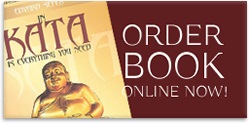IN KATA IS EVERYTHING YOU NEED
Third enlarged edition with four Kata Bunkai and the complete Tang Shou self defense
Written by Edvard Sefer
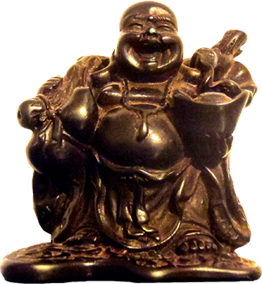
INTRODUCTION
In order to better understand the contents of this book, it would help to be familiar with pressure points fighting. This book explain all rules necessary to start understending the proper Kata value, purpose and Kata Bunkai. Book explains 6 Monk rules for Kata break down, 5 animal styles basicfilosopfy and explanation and 6 Ji hands. Knowing these rules is like knowing a decoding system for Kata.
This book is an introduction to Tang Shou self-defense. Tang Shou self-defense is a Jin (woman= weaker person) approach to self-defense. If you want to learn more about Tang Shou than you will find in this book, you may contact me for discussion, or for an advanced seminar, at sefer@siol.net. The idea for this book was born from the fact that I am getting older and I am not getting faster or more powerful. This brought me to the decision to investigate Kata for self-defense techniques or to stop practicing them. The more I studied Kata, the more they convinced me that you do not have to be six feet tall and muscular to practice karate. In the beginning, this book was written and meant for beginners, middle-aged or older people and those who want to learn self-defense but are not strong, fast or talented. However, the idea grew and the research expanded and developed so the knowledge explained in this book will be very useful for practitioners of all styles as well as high grade karate masters.
The research I have done confirmed one of the most important facts of life: that knowledge is always stronger than muscles and that karate is no exception to this fact.
I was and I am convinced that Kata, where created and practiced, gives knowledge to the weaker person and enables him to beat stronger and faster individuals, and this is the truth and that is why practicing Kata makes sense for everyone at every age. According to Tang Shou, the use of any weapon in any Kata is senseless, because Kata provides a defense against weapons, too. In my country we have a saying that he who carries the sword will die from the sword. So do not carry the sword and your stay on earth will be longer. It is very important to never forget that Karate is 空手道 »kara te do«, or »way of the empty hand« . This is very important because it says to you that you do not need a weapon to defend yourself and the way of empty hand tells you that if you know karate you will be able to defend with your hands against the weapon. Empty hand means literally and truly that your hand is empty so you have many actions available. I think all actions start with an open empty hand, and this is a very important conclusion, too. When studying Kata we should never forget, as Mr. Funakoshi said, “Karate ni sente nashi” or “There is no first attack in Karate”.
Everyone who reads this book will gain new insights into what karate is and will probably never look at karate the same way. This book gives a new (very old) approach to kara te do. I went far back in the past – far before Mr. Funakoshi and Shaolin monks – until I reached the ancient Indian tarkappukalai art of self defense. I studied different karate styles as well and my research lead me to techniques that I decided to name Tang Shou in memory of the Buddhist monk Bodhidharma who brought the knowledge of martial arts to Shaolin monasteries in the beginning of the 5th century AD. Tang Shou self-defense is Bunkai from Kata and is not meant for sport fights or for combat fights. It is meant for surprising fast self defense if you are attacked in your daily life by a stronger person and in fact it is meant for a Monk who needs to defend himself from a younger and stronger bully.
This style of karate is not reserved for the young, strong and fast. I find it to be a nearly senseless fact that you have to be young and strong to practice karate, because if you are six feet tall and full of muscles you do not need karate as much as somebody who has average or below-average strength and who is not young anymore. Why the name Tang Shou? Because everything I will explain can be performed by a lazy old Monk and this means that to practice self-defense you do not need to be strong, fast, talented and young, and what is most important of all in Tang Shou is that you can be a fat old monk and still defend yourself and walk away at the end as a winner.
The most widespread thinking about Kata is that nobody knows what the purpose of Kata is, and that is nearly the truth. This thinking is so widespread that people do not allow you to speak, are not willing to listen to you, and do not want to accept anything you say when you start explaining the theory of how to break down Kata or what a Bunkai can be. They rather stay with common explanations and explanations seen on YouTube or old 8mm Karate movies. In my many years of practicing Karate, I did not meet anybody who could give a complete explanation and I have not seen any explanation on YouTube that fits Tang Shou, and there was no explanation I would accept now days. There are many coming close but they do not give a complete explanation or they give a partially correct and partially useless and senseless explanation.
Everything I am writing about in this book is meant from the view point of Tang Shou and based on the knowledge hidden in Katas. It does not mean that this is absolute knowledge and the only truth, but it is one possible, scientifically supported and practical explanation.
You must be aware that Katas were created by monks in monasteries and monks by belief do not attack people so they never made aggressive techniques. They made only very efficient self-defense techniques based on the theory that “if someone does something to me then I will defend myself”. So any explanation of Kata as an aggressive technique is probably wrong. This basic principle gives you the correct explanation of any Kata movement. You have to imagine that monks were not skinny, but fatter, especially if you look at old drawings and statues of the monks.

In this time, a fat shape meant nobility and wealth and only people who were rich could educate themselves and reach even an even higher level, so a fat shape immediately meant a noble or rich man. This made these men even more interesting targets for robbers so they needed to find the way to be fat, i.e. to be noble, and still be able to protect themselves. Keeping that fact in mind, what we have today in mind about Shaolin monks who are extremely well trained for show and who are only muscle is not what plain, everyday monks are or were at any time and in any religion. So when you do Kata Bunkai you must have this fact in your mind and if you cannot imagine that a particular technique can be performed by an old, fat man then this technique is most probably not the technique as it was originally meant. Techniques are most effective when they are simple and allow you to finish a fight fast, in only a few seconds, before you get tired.
When you do research in karate you have to accept the first rule “that nothing is like you see it,“ so what you see and imagine at first sight is probably wrong unless you have a great knowledge of Bunkai. Besides that, you must accept that writings and drawings about karate from ancient times were not written as they are now when authors try to give their content to everybody in an understandable form. Books and drawings from ancient times were done in a way that kept the techniques hidden and were understandable only to chosen ones, and they led common people or the people that had no right to see the book away from the real meaning. This was the only way to protect the secret and stay alive in case of war.
All who will read this book and practice accordingly will, with knowledge from this book, improve their body shape, condition, and coordination and survival chances in situations that we all actually never want to experience in our life. This book will give at least one Monk explanation to most of the moves and actions known to all who have trained Kata for many years but knew only Jang knowledge. With this knowledge it will be much easier to break down any other Kata. Finally, what is most important is that the techniques described in this book cannot be found, according to my knowledge, anywhere else together in this way.
INTRODUCTION TO Tang Shou
In order to better understand the contents of this book, it would help to be familiar with pressure points fighting. It took me 10 years of studies to come to Monk rules and my level of knowledge where I have at least one explanation for each movement in Kata I do every morning. All this Kata Bunkai can be explained with the use of six Tang Shou rules so I am convinced that any original Kata created by old masters before Anko Itsou, if you done in its original form, could be understood.
I learned Katas from books and videos and I have seen them on the internet in different versions. The best versions are those found on the old, black and white films you can find on the internet. These Katas are not as polished and nice as they do them today, but you can see that the masters performing them know exactly what they were doing. You can also recognize other younger masters doing it perfectly and as beautifully as ballet, but you see immediately that they do not know what they are doing, because if they knew then they would perform them in a different way.
Nowadays you see exaggerated movements such as high kicks and jumps and punches that come to karate from movies or by practitioners who want to impress audiences or their Sensei. When I look at such movies I can see that out of 100 seconds of fighting around 95 seconds is for the needs of the movie and only the last 2-5 seconds is a real fight. I once heard Mr. Dillman saying that he likes his Kata nowadays more than before when he was doing them in excellent form. When I heard that I was astonished at how he dared to change Kata, but now I agree very much.
Some will say that changing Kata movements is not acceptable but the fact is that nobody today knows what the original Kata looks like. Katas were transferred from teachers to students in demonstrative ways, not by books. And I am sure that even teachers did not perform Kata exactly the same way as they learned from their teachers, but during the many years of practice changed some moves on purpose, through forgetfulness, or just through a lack of awareness.
You can find books and on the internet you can see Kata with the same or similar names performed by different masters and they all have different movements even though you can always follow the same line. Nobody knows what the master who made the Kata thought, and nobody even knows for sure who made the Kata. The Kata went through generations and each generation made little changes to it, and what they meant is that Kata is teaching. For the Kata I have at the moment in the form that I like, I went back in the time looking on the internet at old vintage pictures of Mr. Funakoshi and others and took out of each version (style) the aspects that I thought were correct. In particular, I added back into the Katas small details that had been lost through time and took out all of the exaggerations that entered into the Kata in the last century.
To find and to know which version is the correct one, I have followed the dictionaries out of Mr. Masatoshi Nakayama’s books (45-49), the rules of Mr. Dillman’s theory – pressure points and destruction cycles (1-10), Kiai Juitsu from Song T. Park (24-31), and six Tang Shou rules. To be able to do that, it is very important to do more Kata at the same time: do not study only one Kata for five years, but rather study ten Kata for ten years because there are many common moves. I could say that roughly 50-70% of the moves are the same, 20% are specific, and 10% are extra moves. So if you find moves that fit in 10 Kata Bunkai than you can be sure that you have the right explanation.
To start to understand this, it is very important to accept the soft (Ji-Jin) version of Karate and this is left in the poetic Far East perception to older people when Jang is disappearing and Jin is taking over. If expressed in Western perception by Einstein’s formula E=mc2, that tells you that the material world can be transferred to energies and the fact is that as you get older your body becomes weaker, but your mind (energy), if well trained, will take over. So the most important thing in your life is to keep muscles when you are young, and to develop your mind to keep your brain clear when you get old.
To show you the difference between the Jang and Jin approaches to self defense I will present a comparison between the Shaolin (Jang) style and Monk (Jin) style use of the palm and hand. I book Bubishi, written by the Patrick McCarthy (19) there is six Ji hand explanation in life hard to learn way explanation and I will give you the eays to learn and use explanation. You will not need to ruin your palm but you can use six Ji hands even if you are wooman with painted nails.
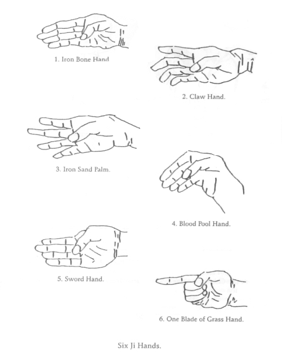
First we will focus on page 201of the aforementioned book that presents an explanation for Six Ji Hands of the Shaolin style and provide a Tang Shou 6 Ji hands applications explanation.
Shaolin monk style and Tang Shou are like Jang and Jin connecting together, but on completely opposite sides:
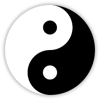
Shaolin monk style is white: a simple, strong and aggressive version tending to dominate, at least visually. Tang Shou is dark: orientated toward femininity, using the mind to overcome strength. Jin, even in the Chinese language, means evil force. So Tang Shou gives you a Jin explanation and Shaolin monk style gives you a Jang explanation. Jin is black and that’s why practitioners of the Tang Shou wear black dressing and shoes!
Jang style uses punches with fists and the fist must be in a straight position so that it is well supported by hand bones and muscles.


Be aware that we have strong abductor muscles on the inside of the palm that connect the palm with the hand, and that there are nearly no muscles on the outside of the palm to connect the palm and the hand. Due to this reason, keeping the palm in a straight direction and position is very important to protect against injuries suffered by the palm bending after a punch. I think everybody has experienced an injury like this once in their life. In the Jin style we do not use the fist at all, but out of six Ji hands we use four for punching and two for catching. This will be explained in detail later.
The fact is that after I discovered the Tang Shou explanation of six Ji hands I stopped using the fist at all. I changed all fist strikes to Ji hand applications and they fit in perfectly. It is probable that all original Kata did not use the fist, but instead used Ji hand forms! Just remember that all writing nowadays about karate are explaining how Mr. Funakoshi and other masters from the modern age have changed Kata to less dangerous forms to prevent kids from killing each other when fighting between themselves. It is likely that no one these days knows what they did, but this could be an answer.The most interesting of all is that Bruce Lee used in his first movies done in Hon Kong 6 Ji hands as they are described in this book.
For a better understanding of what I am talking about regarding the difference between a Jang approach and Tang Shou Jin approach, I will give here in advance a simple comparison between Bunkai explanations in Jang and Jin approaches. In accordance with Tang Shou split Kata self-defense, I will explain another self-defense action from Heian Shodan Kata. The Jang explanation is taken out of JKA President Mr. Hirokazu Kanazawa’s last book (2010) “Karate: The Complete Kata“, Kodasha USA.



The Jang explanation uses a lot of power and adds a killing move on the end with a hammer fist strike on the top of the skull.



Today, such moves are not the best to use if you do not want to finish in jail. The fact is that in the middle and on the top of the skull there is a connection between two bones that is in the form of cartilage for the whole time of the skull growth. Even during older age when the cartilage changes to bone, this is one of the places on the skull that is easier to break and penetrate to the brain and that’s why even pointing with a finger to this place make us feel uncomfortable. Harming this part of the brain causes motor (moving) dysfunctions because the Premotor Cortex and Motor Cortex – two parts of the brain that control human (motor) moving abilities – are under the skull in this area. So this is real a Jang approach, like my great grandfather used when he was killing bulls. He was a butcher and was strong but did not know anything about Monk style karate.
The Tang Shou Jin approach is completely different. The Monk is not so strong, so from the beginning he has a different Bunkai approach, because he is not able to pull his hand out or hit someone who is much stronger. You may see on the picture below what happens in a real situation. The weaker person can, at best, succeed in pulling up the hand, but at the same time he opens frontally to a stronger person and gives him a place for the final punch. So this makes no sense, because a stronger person does not need karate to beat a weaker one, but the weaker person needs karate to beat the stronger one. This is a basic fact about karate.
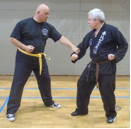
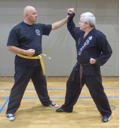
We have to be aware that a weaker person does not normally attack a stronger person. Tang Shou does not expect that one will hold another’s stronger right hand with their weaker left hand, unless he is much, much stronger. In such a position, the Monk will not move his front leg back, but he will move all his body back to introduce his weight and gravity force in order to escape out of the hold like men do in rope grappling games or as explained by vector analyses in physics.
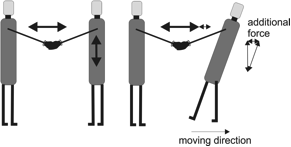
Tang Shou Bunkai teaches us to use these Kata movements to defend from a cross right hand to a right hand catch or an attacker right hand catch to the Monk’s left hand. Why? The Monk will use the first part of the Kata movement to change the side and come behind the back of attacker and that will do the rest. This self-defense move can be used solely for protection or in a killing action, but everything happens and is executed from a safe position where the attacker can no longer do harm.
 The Monk will hit with the left hand to the attacker’s GB 25 point alarm point for the Bladder meridian. Dis will raise the attacker so that the Monk will be able to do a (Gedan Barai) hit catch to BL10 or GB20 point to knock out the attacker, then hold his hair or jacket or, if he is a skin head, his chin. The Monk can then pull him in a turning position down to floor or can kill him by attacking more bladder points.
The Monk will hit with the left hand to the attacker’s GB 25 point alarm point for the Bladder meridian. Dis will raise the attacker so that the Monk will be able to do a (Gedan Barai) hit catch to BL10 or GB20 point to knock out the attacker, then hold his hair or jacket or, if he is a skin head, his chin. The Monk can then pull him in a turning position down to floor or can kill him by attacking more bladder points.
REFERENCES
- Dillman, George A., and Chris Thomas. Advanced pressure point grappling. , George Dillman Karate International, 1999.
- Dillman, George A., and Chris Thomas. . George Dillman Karate International, 2000.
- Dillman, George A., and Chris Thomas. Advanced pressure point fighting. George Dillman Karate International, 2000.
- Dillman, George A., and Chris Thomas. Dillman pressure point Method. George Dillman Karate International, 1999.
- Dillman, George A., and Chris Thomas. Human pressure point Self-Defense, George Dillman Karate International, 2002.
- Dillman, George A. “Tuite-Cavity strikes- Nerve attack, Grappling points of Pinan Katas.” Video.
- Dillman, George A. “Tuite-Cavity strikes- Nerve attack, Grappling points of Nai Han Chi Katas.” Video.
- Dillman, George A. “Bassai Kata.” Video.
- Dillman, George A. “Seisan Kata.” Video.
- Dillman, George A. “For Police Only – Pressure Point Control Technique.” Video.
- Jay, Wally. Small Circle Jujitsu, Ohara Publications, Inc, 1989.
- Jay, Wally. Advanced Small Circle Jujitsu- Fulcrum Activation, TC media Inc., 2001. DVD.
- Jay, Wally. Small Circle Jujitsu Fulcrum Activation Tape #1, Black Belt Magazine, 1988. Video.
- Kline, Mark. Kata Taikyoku. Video.
- Kline, Mark. Wanshu Kata. Video.
- Kline, Mark. Kusanku. Video.
- Kline, Mark. Seichin Kata. Video.
- Kin Ken Kata, Kyusho international. DVD.
- McCarthy, Patrick. Bubishi, Tuttle publishing, 2008.
- Burgar, Bill. Five years one Kata, Martial Arts Publishing Limited, 2003.
- Corn, Jim. Double Tap Volume 2, Budo Internatzional Publ. Co., 2007. DVD.
- Pantazi, Evan. Energetic transfer, 2008. DVD.
- Chang, Stephen Thomas. popolni sistem samozdravljenja, Tomark d.o.o. Ljubljana, 1996.
- Park, Song T. Kiai Jitsu Fightihng Method, Kiai jitsu TM International, 2005.
- Park, Song T. 5 elements healing. DVD.
- Park, Song T. 8 foundations. DVD.
- Park, Song T. Kiai jin jitsu Healing method part 1. DVD.
- Park, Song T. Kiai jin jitsu Healing method part 2. DVD.
- Park, Song T. Kiai jin jitsu Healing method part 3. DVD.
- Park, Song T. Kiai jin jitsu No touch Blocks & Parries. DVD.
- Park, Song T. Kiai jin jitsu Fighting method. DVD.
- Lovincic, Davor. San Chin Kata. Video.
- Brennan, Barbara Ann. Moč zdravilnih rok, Dušan Doblanovič Jimmy, 1995.
- Brennan, Barbara Ann. Prebujajoča svteloba, Dušan Doblanovič Jimmy, 1996.
- Lübeck, Walter. Reiki, Dušan Doblanovič Jimmy, 1990.
- Verbe, Božidar. Reiki priročnik za II stopnjo,
- Vora, Devendra. Zdravje je v tvojih rokah, Sanjska knjiga d.o.o., 1996.
- Kelder, Peter. Vrelec mladosti 5 tibetanskih vaj pomlajevanja, Vale Novak, 1993.
- Cadaine, David and David Nakahara. Tai Chi workout, Henry Holt and Co., 1994.
- Spielman, Ed. The Spiritual Journey of Josepf L. Greenstein, The Viking Press, 1994.
- Fontana, David. Zen meditacija, Maldinska kniga, 2004.
- Dedopulos, Tim. Kabala, Mladinska knjiga. 2006.
- Maharaji Fulfillment. Video.
- Nakayama, Masatoshi. Dynamic karate, Kodasha International, 1986.
- Nakayama, Masatoshi. Best karate, Heian, Tekki 5, Kodasha International, 1979.
- Nakayama, Masatoshi. Best karate, Jitte, Hangetsu, Empi 7, Kodasha International, 1981.
- Nakayama, Masatoshi. Best karate, Gankaku, Jion 8, Kodasha International, 1981.
- Nakayama, Masatoshi. Best karate, Bassai Sho, Kunku Sho, Chinte, Kodasha International, 1985.
- Sugiyama, S. et al. 25 Shoto-kan Kata, J. Toguri Mercantile Co., 2000.
- Rielly, Robin L. Shotokan Karate, 2000.
- Shaw, Scott. Hapkido, Charles E. Tutle Company, 1996.
- Vračarevič, Ljubomir-Ljuba, Aikido Sportska knjiga, 1983.
- Moulton, Allen and Chong Moulton. Traditional Okinavan Karate Volume 1 Uechi ryu basic.
- Kiew Kit, Wong. The Shaolin Arts. Cosmos Internet Sdn Bhd, 2002.
- Kiew Kit, Wong. The complete book of Chinese Medicine, Cosmos Internet Sdn Bhd, 2002.
- Kiew Kit, Wong. The Art of Chi Kung, 1993
- Šefer, Edvard (2009) In kata is everthing you need, 2009.
- Lee, Bruce Tao of Jeet kune do, 1975. Reprint: Linda Lee, 2010.
- Samurai strategies. Boye Lafayette De Mente Turtle Publishing, 2005.
- Pantazi, Evan. Six Ji hands of Bubishi. DVD.
- Kanazawa, Hirokazu. Karate: The Complete Kata, Kodansha USA, 2010.
- Funakoshi, Gichin. Karate-Do: My Way of Life, Kodasha International USA, 1981.
- Funakoshi, Gichin. Karate-Do Kyohan: The Master Text, Kodasha International USA, 1996.
- Funakoshi, Gichin. Karate-Do Nyumon: The Master Introductory Text, Kodasha International USA, 1994.
- Shosin, Nagame. (1996) The essence of Okinawan karate-do (shorin ryu),Tuttle, 1996.
- Kanazawa, Hirokazu. Karate: The Complete Kata, Kodasha USA, 2010.





